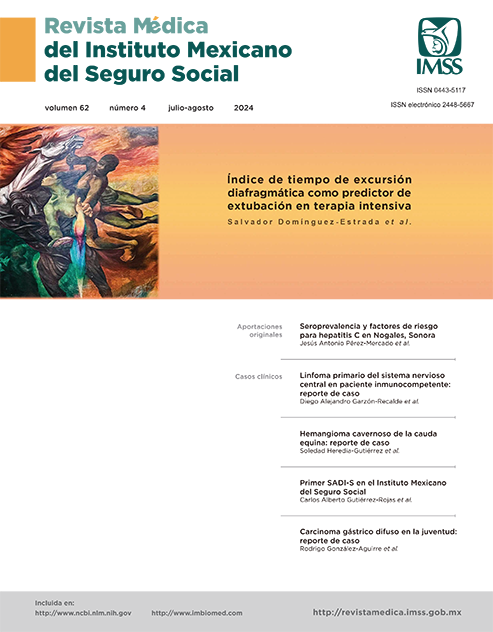Hemangioma cavernoso de la cauda equina: reporte de caso
##plugins.themes.themeEleven.article.main##
Palabras clave
Cauda Equina, Hemangioma Cavernoso, Nervios Espinales, Dolor de la Región Lumbar
Resumen
Introducción: los hemangiomas cavernosos son malformaciones vasculares formadas por grupos de sinusoides dilatados, organizadas en canales con una sola capa de endotelio. Los hemangiomas cavernosos representan el 3% de todas las lesiones intradurales y de estas, un 5-12% corresponden a lesiones de la médula espinal, Los de la cauda equina son poco frecuentes.
Caso clínico: hombre de 57 años, sin antecedente de radioterapia, presentó dolor en la región lumbar y contractura de la musculatura dorsal y paraespinal desde hacía seis meses, evaluado en otro hospital y diagnosticado con una herniación discal lumbar. Fue manejado con analgésicos y fisioterapia durante dos meses, sin embargo, fracasó la terapéutica y la sintomatología empeoro. Presentó disestesias en la región glútea y perianal, y reducción de la fuerza en ambas piernas, así como afección de esfínter vesical. Se le realizó una resonancia magnética simple de la columna lumbosacra, evidenciando una lesión intrarraquídea e intradural a nivel L1-2. Fue diagnosticado con síndrome de cauda equina y se llevó a cabo cirugía. Posterior a la cirugía, el paciente presentó mejoría clínica y resolución de los síntomas. En el seguimiento en consulta externa, el paciente logró deambular de forma independiente y actualmente se encuentra asintomático. El resultado de anatomía patológica reportó un hemangioma cavernoso.
Conclusiones: los hemangiomas cavernosos de la cauda equina son raros y cuando se asocian a un síndrome de la cauda equina la cirugía temprana se recomienda como el tratamiento de primera elección para evitar un daño neurológico permanente.
Referencias
Ridley LJ, Han J, Ridley WE et al. Cauda equina: Normal anatomy. J Med Imaging Radiat Oncol. 2018;62 Suppl 1:123. doi: 10.1111/1754-9485.04_12786.
Vicenty JC, Fernandez-de Thomas RJ, Estronza S et al. Cavernous Malformation of a Thoracic Spinal Nerve Root: Case Report and Review of Literature. Asian J Neurosurg. 2019;14 (3):1033-1036. doi: 10.4103/ajns.AJNS_249_18.
Patet G,Bartuli A, Meling TR et al. Natural history and treatment options of radiation-induced brain cavernomas:a systematic review. Neurosurg Rev. 2022;45(1):243-251. doi: 10.1007/ s10143-021-01598-y.
Koester SW, Scherschinski L, Srinivasan VM et al. Radiation-induced cavernous malformations in the spine: patient series. J Neurosurg Case Lessons. 2023;5(23). doi: 10.3171/ CASE22482.
Riolo G, Ricci C, Battistini S. Molecular Genetic Features of Cerebral Cavernous Malformations (CCM) Patients: An Overall View from Genes to Endothelial Cells. Cells. 2021;10(3):704. doi: 10.3390/cells10030704.
Hong T, Xiao X, Ren J, et al. Somatic MAP3K3 and PIK3CA mutations in sporadic cerebral and spinal cord cavernous malformations. Brain. 2021;144(9):2648-2658. doi: 10.1093/brain/ awab117.
Nie QB, Chen Z, Jian FZ et al. Cavernous angioma of the cauda equina: a case report and systematic review of the literature. J Int Med Res. 2012;40(5):2001-2008. doi:10. 1177/030006051204000542.
Caroli E, Acqui M, Trasimeni G et al. A case of intraroot cauda equina cavernous angioma: clinical considerations. Spinal Cord. 2007;45(4):318-321. doi: 10.1038/sj.sc.3101964.
Albalkhi I, Shafqat A, Bin-Alamer O et al. Long-term functional outcomes and complications of microsurgical resection of brainstem cavernous malformations: a systematic review and meta-analysis. Neurosurg Rev. 2023;46(1):252. doi: 10.1007/ s10143-023-02152-8.
Liao D, Wang R, Shan B et al. Surgical outcomes of spinal cavernous malformations: A retrospective study of 98 patients. Front Surg.2023;9:1075276. doi: 10.3389/fsurg.2022.1075276.
Yang T, Wu L, Yang C et al. Cavernous angiomas of the cauda equina: clinical characteristics and surgical outcomes. Neurol Med Chir (Tokyo). 2014;54(11):914-923. doi: 10.2176/nmc. oa.2014-0115.
Khalatbari MR, Hamidi M, Moharamzad Y et al. Cauda equina cavernous angioma presenting as acute low back pain and sciatica. A report of two cases and literature review. Neuroradiol J. 2011;24(4):636-642. doi: 10.1177/197140091102400421.
Kumar V, Nair R, Kongwad L et al. Cavernous haemangioma of the cauda region: case report and review of literature. Br J Neurosurg. 2017;31(5):614-615. doi: 10.1080/02688697. 2016.1199784.
Takeshima Y, Marutani A, Tamura K et al. A case of cauda equina cavernous angioma coexisting with multiple cerebral cavernous angiomas. Br J Neurosurg. 2014;28(4):544-546. doi: 10.3109/02688697.2013.841856.
Yaltirik K, Özdoğan S, Doğan Ekici I et al. Cauda equina cavernous hemangioma: very rare pediatric case. Childs Nerv Syst. 2016;32(12):2289-2291. doi: 10.1007/s00381-016-3286-9.
Golnari P, Ansari SA, Shaibani A et al. Intradural extramedullary cavernous malformation with extensive superficial siderosis of the neuraxis: Case report and review of literature. Surg Neurol Int. 2017;8:109. doi: 10.4103/sni.sni_103_17.
Apostolakis S, Mitropoulos A, Diamantopoulou K et al. Cavernoma of the cauda equina. Surg Neurol Int. 2018;9:174. doi: 10.4103/sni.sni_212_18.
Naleer H, Manivel M, Bathala R et al. Lumbar spinal nerve root cavernoma: A rare cause of Intradural extramedullary lesion–Case report. Interdisciplinary Neurosurgery 32 (2023): 101737.doi: 10.1016/j.inat.2023.101737.
Hart BL, Mabray MC, Morrison L et al. Systemic and CNS manifestations of inherited cerebrovascular malformations. Clin Imaging. 2021;75:55-66. doi: 10.1016/j.clinimag.2021.01.020.
Bennett SJ, Katzman GL, Roos RP et al. Neoplastic cauda equina syndrome: a neuroimaging-based review. Pract Neurol. 2016;16(1):35-41. doi: 10.1136/practneurol-2015-00123.


